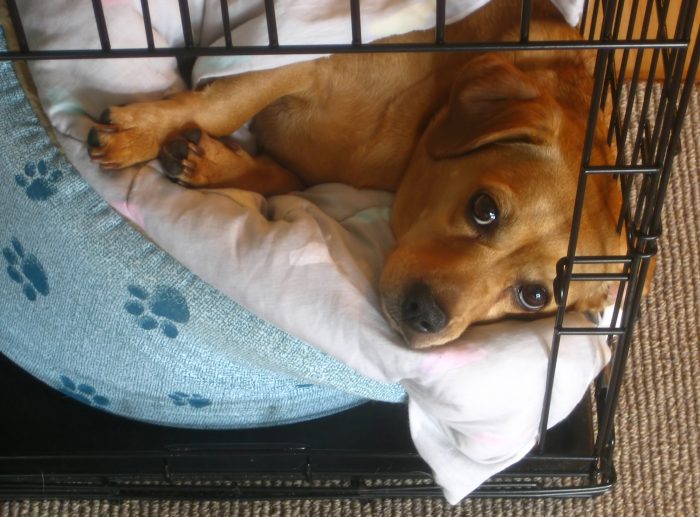Welcoming a new puppy into your home is cause for celebration, but with the excitement of this newfound joy comes the need to establish boundaries.
Crate training is fundamental to obedience training—that is, acclimating your dog to a crate he can call home inside the home. Over the years, this practice has gained a bad rap as cruel and unusual punishment but don’t fret, it’s actually natural.
For thousands of years, dogs sought out dens as a safe space to rest or nurture a family. When implemented properly, crate training can create a sense of safety and security for your pup, comfort your dog when you have to step outside, and save your furniture or favorite pair of shoes from total devastation!
How to Crate Train Your Puppy
When crate training your puppy, the most important thing to keep in mind is to create a positive experience. Never use the crate as punishment, or your pup will begin to resist it. Training can take anywhere from a few days to a few weeks so patience is essential, as is breaking the process down into gradual steps.
Step 1: Introduce your dog to the crate
Create a positive association with the crate from day one by making it a homey, welcoming space. Place the crate in a populated area of your house so your dog still feels like part of the family, and make it inviting by laying soft blankets or towels inside. Leave the door open so your dog can sniff around and start to get used to it.
If your dog is still resistant, try placing his favorite toys or treats closer and closer to the crate, then inside the door, and finally, all the way inside. Don’t ever try forcing your dog into the crate, but keep encouraging him with a warm, friendly tone of voice.
Continue placing treats or toys into the crate until your dog feels confident enough to step completely inside. Again, this can take anywhere from minutes to days; there’s no need to rush the process.
Step 2: Introduce meal time in the crate
Once your dog gets a taste of the crate, it’s time to get him comfortable with staying inside for longer periods of time. One of the best ways to do this is to introduce meals inside the crate.
Depending on how comfortable your dog is at this step, place the bowl of food just inside the opening of the crate and move it further back with each meal. Once your dog is comfortable staying inside to eat, try closing the door, but open it as soon as he’s finished eating. With each meal, leave the door closed just a while longer until your dog is comfortable staying inside for at least 10 minutes after meal time.
If your dog starts to whine, lessen the period of time you leave him inside. If the whining continues, try releasing him for a few minutes before returning him to the crate. The goal is to show him that you are still there for him, even if not physically nearby.
Step 3: Introduce longer periods in the crate
Congratulations. You did it! Your dog is confidently receiving meals inside the crate. If you’re reading this step and are still having trouble, don’t worry. All it takes is a bit of patience and positive affirmation to keep your dog interested. Repeat steps 1 and 2 until he’s ready to move forward.
Now it’s time to introduce more crate time, working up to the day you are able to leave the house with your dog comfortable inside the crate.
Try this gradual exercise:
- Implement commands to enter, such as “kennel”. Motion to the crate with a treat in your hand.
- Once your dog has entered the crate, affirm him verbally and then administer the treat. Close the door while he enjoys the treat inside.
- Sit nearby without saying a word, then leave the room for a few minutes. Return, sit for a short amount of time once more, and then let your dog out of the crate.
- Repeat this process throughout the day, increasing the time you’re gone from his side.
Once your dog can sit quietly inside without you being nearby for at least half an hour, try leaving him in the crate for even longer periods of time, and then, overnight.
And when that’s complete? It’s time for Step 5: treating yourself for all your hard work!
With dedication and patience, your canine will one day cozy up to his crate so you can be free to step out… until your return home, and the promise of a well-deserved cuddle.






